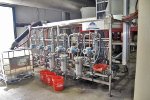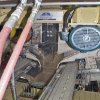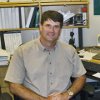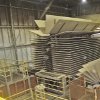Cresting the wave
4 December 2009Flakeboard’s Eugene MDF mill is cresting the wave of production improvement with a new resin process created in the firm’s St Stephens mill in Brunswick, Ontario, Canada.
Dieffenbacher’s Sunds MDF Technologies, Sundsvall, Sweden, produces the equipment.
It is known as EVOjet and is a dry blending system that introduces resin after the dryer. It not only saves expensive resin (some 30% at Eugene), but also provides better distribution, according to Sean Coffey, Flakeboard’s Eugene plant manager.
The mill was originally a Bohemia Lumber Co particleboard operation which Willamette Industries bought and converted to recycled wood based MDF before Weyerhaeuser Company bought Willamette and converted the mill to fresh sawdust and shavings as the wood supply.
Later, Flakeboard bought it, among five Weyerhaeuser mills, making Flakeboard North America’s largest MDF producer.
The present wood supply, 200 to 220 tons per day, is sawdust and shavings, all from within a 100-mile radius of Eugene – mostly closer. It’s all green and primarily Douglas fir, although a very small amount of hardwood goes into the mix. “The plant has been good at adapting to what comes our way,said Mr Coffey.
“At times we have run 90% sawdust,he said. “You have to know how to move with the market. As an example, during a recent holiday period, sawmills were down and we swung to chips.
The mill has one truck dump, which accommodates 51ft trucks.
A front-end loader mixes on the floor of the furnish area and feeds three silos which meter out to pre-steam bins. An ‘Andritz Sprout-Bauer 150’ 60-in refiner is coupled to an 8,000hp synchronous motor. Retention time in the digesters is 21⁄2 to 3 minutes.
A short blowline goes to a Westec primary flash tube dryer, heated with a Coen Energy system which can burn natural gas, dust, or a combination of the two. The system uses 95% dust and switches automatically to gas if there is a dust supply problem.
A flash tube dryer goes to two primary cyclones. The moisture content target is 17%. Dryer exhaust gas goes through an electrostatic precipitator (ESP). Paraffin wax is the only additive ahead of the dryer.
Conveyors can act as a fire dump or convey forward to a Sunds weigh belt which weighs the material to automatically determine resin addition in the EVOjet, the star of the system. Fibre is in the bin for not more than 10 minutes.
“Two high-speed rotating spike rolls are the heart of process,Mr Coffey explained. “The material comes in on the main infeed fan and a flow splitter just above the resinator. This divides it into two equal streams. A gate assures that the torque on the two spike rolls is even, to disintegrate the material. This produces a nice, fluffed-up fibre.”
“Two high-speed rotating spike rolls are the heart of process,Mr Coffey explained. “The material comes in on the main infeed fan and a flow splitter just above the resinator. This divides it into two equal streams. A gate assures that the torque on the two spike rolls is even, to disintegrate the material. This produces a nice, fluffed-up fibre.where the streams join.
The nozzles are installed on moveable bars so they can be automatically cleaned while operating.
Pre-resinated fibre recirculates back around the system. This protection fibre sandwiches the resinated fibre and protection fibre to keep fresh resin off the walls to prevent sticking. It’s all air driven.
Warm air is forced around the nozzles to maintain a 50º to 60ºC temperature.
The fibre then goes up through a tower around into the main cyclone where warm air is recycled into the system. Western Pneumatics installed that system as well as much of the other new machinery.
A main feeder serves an 8x50x8ft retention bin, where the amount of retention fibre is determined.
Fibre proceeding to the line is relayed to a bin feeding two Washington Iron Works vacuum formers. This is a 4ft homogeneous line, but could be converted to 5ft width.
The mat goes through a 125 to 200psi roller pre-press and is cross-cut to panel size ahead of the loader to the Washington Iron Works 4x16ft, 13-opening press; two platens were pulled out of an existing 15-opening press to provide room for the MDF. The press is totally enclosed for air protection.
The line can use higher moisture content raw material because the resin does not cause blisters. It can run at 19 tons per hour, using both MDI and UF resins.
The line produces thicknesses from 1⁄4in up to 11⁄4in and a density as low as 34lb/cu ft, North America’s lowest-density MDF. The Premier product is 45lb/cu ft, but the line can make up to 60lb/cu ft density.
“We engineer products to what our customers want. We do all we can to serve those customers,Mr Coffey declared.
Pressed panels go through two board coolers, then a standard star cooler.
The Globe saws are in-line. A Kimwood sander installation has a two-head sizing head into a six-head unit, followed by a cross-belt going into one of two grade bins. A CTC feeder system is installed.
The mill is compliant with all air standard regulations and has a biofilter installation.
Mill capacity is 85 million ft2 running four shifts, but with the present poor market situation it is running three shifts for 10 days and then goes down for five days. There are 50 hourly-paid employees.
Flakeboard is quite safety and employee oriented. The mill is unusually clean and Mr Coffey believes this is one of the factors for good employee morale. “We have a very good workforce, very empowered,he said, “We have an outstanding resin system, combined with an outstanding workforce.
California is the primary market, but Oregon and Washington are important too. Most of the output is trucked, but there is space for five rail cars on the railroad spur.
Flakeboard broke ground on the resin project in July and the system was ready to run on December 31, with 8 days of commissioning before they were ready to run around the clock.
Flakeboard, with its eight mills in US and Canada, makes a variety of particleboard, MDF and thin, high density MDF.
The company’s 2006 purchase of three MDF and three particleboard plants from Weyerhaeuser added 1.1 billion ft2 of capacity.
A new product is eLITE light-weight MDF from the Eugene mill. It is 30% lighter than standard MDF, resulting in freight savings, shorter lead time, labour benefits and extended tool life.
Looking at the past, Flakeboard was the first to continuous-press particleboard and apply melamine faces continuously, among many other firsts for this innovative company.



